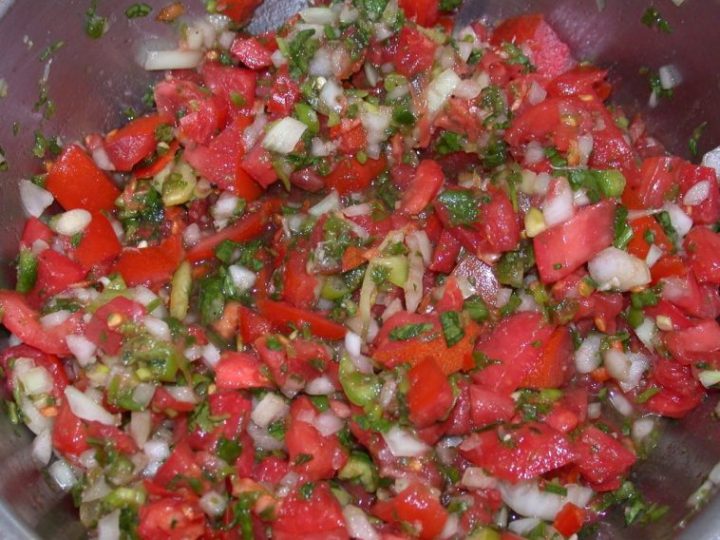My salsa catalogue has numerous entries. Some accommodate the seasons, some entertain strange ingredient lists, and others still are made for quick convenience. After weeks of my annual garden-inspired pico de gallo indulgences, I took a few extra minutes today for a quick bit of roasting to make another favourite when tomatoes are plentiful.
Before I talk about fire, my standard fresh salsa recipe is as simple as my ‘margaritas for drunks’ recipe*. You can absolutely make this by hand but if you know how your food processor behaves with the different components, it becomes a task of seconds instead of minutes. Amounts are all to taste.
- Add fresh garlic, chiles of any heat desired, and fresh coriander leaf. Whirr to the smallest size possible.
- Add sweet onion halves, fine sea salt, and fresh lime juice. Whirr three pulses to reduce the onion.
- Add heaps of halved fresh tomatoes and continue to pulse until it looks like what you want.
- Chill an hour before serving. Don’t refrigerate long term or the uncooked tomatoes go mealy in texture.
- Eat it all the same day. I doubt you’ll need reminding on this count.
If you used all your limes making margaritas, lemon or cider vinegar can be substituted for the acid. If you’ve got clean coriander stalks, they can go in at the start to get chopped down thoroughly. If you feel like adding freshly ground black peppercorn or toasted and ground cumin seed for an interesting twist a little goes a long way here. I core the stem ends from my tomatoes but don’t bother to remove the seeds for this salsa and if yours aren’t quite as sweet as you’d like, a couple spoons of sugar or honey dissolved in the juice then tossed well throughout is acceptable. Speaking of juice, this usually ends up with quite a bit of liquid in the bowl after it has had time to come together and while that might not stick to your tortilla chips, it’s pure flavour that shouldn’t be tossed out. After an hour I set my salsa in a strainer to collect said juices for soups and bean making.
This sort of affair goes by many names. Salsa fresco (“fresh salsa”) or salsa picada (“chopped sauce”), salsa Mexicana in reference to the colours of the Mexican flag, or pico de gallo (literally “beak of the rooster”), a name hinting that much hotter chiles have been included which is usually my bent. No matter the name, it’s pure simplicity. It takes me three times as long to pull the ingredients out of the garden than it does to make a batch.
The Maillard reaction has been discussed ad nauseam among food types since its discovery in 1912 by the French chemist whose name it bears. Perhaps for good reason as it’s an important basis for understanding food chemistry. Still, end results in the kitchen are more interesting to most non-nerds so here’s the gist of it; roasting certain ingredients under heat multiplies and enhances the flavour you get from them. This is why most anything golden brown tastes so good. From seared steaks to roast coffee to toast, you don’t need a degree in food chemistry or to even know what an amino acid is in order to taste the effects and no more obvious is this boost than with tomatoes.
Whether you give them time in a dry pan, under a broiler, or my favourite method over low charcoal, molecular changes from the extra step under fire yield altered and intensified tastes that are significant even before you add in any benefits from smoke that might be in the mix. You can thank the Maillard reaction as well as plain old carmelization for the flavour. You can thank me for reminding you that charcoal cookery should be part of your repertoire.
To make roasted salsa, put garlic cloves, halved onion and tomatoes, and whole chiles in a grill basket or on a sheet pan all unpeeled. Lightly oil the side to be fired with any you have handy (I like corn oil here) and broil until well charred. Peel the onions, garlic, and chiles afterwards but leave the beautifully darkened skins of the tomatoes in your recipe. Make as above using the charred ingredients.
As an aside, you can use the same roasting technique to start most any soup or stock that deserves a kick and indeed most any vegetable will benefit from sitting under intense heat for a short while, e.g. butternut bisque or oven-roasted broccoli.
For my tastes, I actually prefer a mix of roasted and unroasted ingredients to satisfy my texture inclinations so usually hold back a third of the veg from the oven or grill then reintroduce them to each other in the processor. The advantage of roasting everything however is that it keeps in the fridge ahead of taco night and that time parked marries the flavours better. If I’m going to roast the whole lot to make in advance, I usually can’t resist slipping a few ears of corn in and if a tropical mood strikes, half a pineapple finds its way onto the coals for a while to sweeten the mix.
This barely scratches the surface of salsas but count on at least two in my inventory at any time. How many do you have on hand?
Note: Look at my off-season habanero salsa if it’s January when you read this.
* Add one tin of ordinary frozen limeade (e.g. Minutemaid brand) to a blender. Pour in the same volume of tequila. Top up the blender with ice. Whirrr. Done. Salted glasses optional. Even drunk people can remember this recipe.



